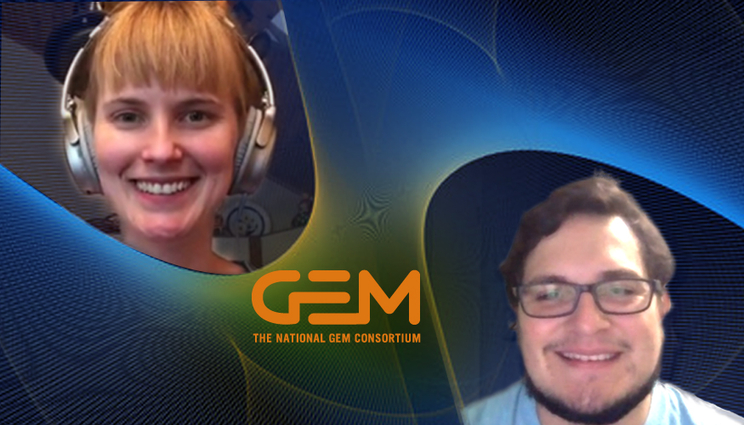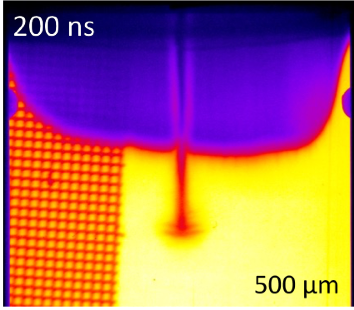Doctoral fellow improves codes used to simulate interactions between particles moving at high velocities
 (Download Image)
(Download Image)
LLNL physicist Alison Saunders and doctoral fellow Marco Echeverria meet online to discuss their progress enhancing codes used during high-energy experiments.
Doctoral student Marco Echeverria is spending his second summer conducting research for Lawrence Livermore National Laboratory (LLNL), but this year his summer experience is taking place at a distance — from his home in Connecticut.
Echeverria is one of hundreds of LLNL summer students who needed to shift to a virtual internship or fellowship due to the pandemic. “The connections I built last summer helped foster a smooth transition to this year’s virtual work environment,” said Echeverria, who is collaborating with the same research team he supported last summer.
The team is exploring interaction between ejecta — particles ejected from a material's surface following shock-driven processes that cause the micron-sized particles to travel at high velocities. For example, they are studying metal ejecta generated from copper and tin material samples during high-power laser experiments, comparing how the mass, velocity and material phase (e.g., liquid or solid) influences particle interaction.
According to LLNL physicist Alison Saunders — who supervised Echeverria’s work last summer and continues to provide mentoring this summer — gaining a better understanding of ejecta interactions has a broad range of applications, such as spacecraft shielding, cold-spray welding, additive manufacturing and understanding material strength at small scales.
A radiography image of an ejecta microjet traveling downward (with the laser drive coming from above), captured during experiments conducted by LLNL’s research team as part of their efforts to characterize ejecta interactions.
During this summer’s fellowship, Echeverria is improving hydrodynamics codes used to model phenomena that occur during these high-energy experiments. “It’s challenging to simulate the material’s microstructure at a large scale,” he explained. “By feeding better experimental data into the hydrocodes, combined with data from molecular dynamics, scientists can conduct more realistic simulations at experimental scales.”
Echeverria is a GEM fellow, sponsored by LLNL. The National GEM Consortium is a network of corporations, national laboratories, universities and other research institutions that enables qualified students from underrepresented communities to pursue graduate education in science and engineering.
According to Echeverria, one of the benefits of the GEM program is that it helps build connections with mentors and employers, giving students an opportunity to explore environments where they might want to work after graduation.
Echeverria is earning a doctoral degree in materials science and engineering from the University of Connecticut and had originally planned a career in academia. After experiencing the research environment at LLNL, his plans shifted.
“I really like the close connection between experimental work and modeling that’s possible in a national lab research environment,” Echeverria said. “It’s exciting to be able to reverse-engineer simulation codes based on experimental results.”
According to Saunders, the research team was happy to welcome Echeverria back this summer. “During last summer’s internship, he was able to learn about LLNL’s computing infrastructure and the molecular dynamics codes used at our Lab. As a result, he was able to hit the ground running this summer with his simulation efforts and is already producing high-quality results.”
Although his work this summer can be done remotely, Echeverria says he misses being on-site at LLNL, viewing the experimental setup and interacting in person with the team’s experimentalists. However, the team quickly shifted to virtual communication during the pandemic, including weekly team meetings and daily interactions with his mentors — Saunders and physicist Tomorr Haxhimali. Screen sharing during meetings makes it easy for everyone to view the code he is developing and identify anything that needs to be adjusted.
“We are thrilled that Marco chose to spend a second summer with us,” said Will Evans, who leads LLNL’s Physics Division. “Sponsoring GEM fellows is an important part of our efforts to attract a diverse group of talented young physicists to the Laboratory and expand collaborations that strengthen diversity and inclusion in the broader physics community.”
Echeverria’s research fellowship is part of Saunders’ project known as Metal Ejecta: Recollection, Interaction and Transport (MERIT), which is sponsored by LLNL’s Laboratory Directed Research and Development program.
— Lisa Valdez
Contact
 Anne M. Stark
Anne M. Stark
[email protected]
(925) 422-9799
Related Links
National GEM ConsortiumTags
Physical and Life SciencesCommunity Outreach
Featured Articles








